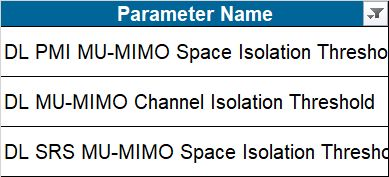Hello Experts.
R17 UE in mu-mimo can get 4 layers DL, right?
Admin note: this post was updated with image below.

Hello Experts.
R17 UE in mu-mimo can get 4 layers DL, right?
Admin note: this post was updated with image below.

This is from 5G NR Bullets Book:
13.6.3.3 TYPE 2 SINGLE PANEL CODEBOOK
‘Type 2’ codebooks are intended for Multi User MIMO (MU-MIMO) with support for a maximum of 2 layers, i.e. 2x2 MIMO. They
provide more accurate Channel State Information than Type I codebooks but also generate a larger signaling overhead. Rank I and Rank 2 PMI indices belonging to a Type I codebook identify a preferred beam and an inter-polarization co-phasing phase shift. PMI indices belonging to a Type 2 codebook identify a set of beams and a set of amplitude coefficients. These amplitude coefficients are used to generate a weighted combination of beams. The Type 2 codebook also identifies a phase shift for co-phasing between beams.
Nokia tested that 16 layers in DL with MU-MIMO at 23R1.
Huawei has it since 2 years ago.
It has 4 PDCCH layers, 16 PDSCH layers plus SSB beams.
4G or 5G?
Huawei has since the beginning, but they never test up to 16 layers in 5G.
It is 5G.
Yes true, Huawei is leading.
But Huawei didn’t test it till last year, as I know.
Most important is to test in a secure envinroment and share the results in public.
It depends of cutter type.
In open space MIMO does not work well.
It needs multipath.
Yes, like rank4.
Similar, I am investigating the different SSB beam which users must be scheduled.
Well, not so sure if this is a requirement…
For MU-MIMO it needs special location of paired users.
Otherwise will not be paired for MU-MIMO.
This can be tricked by parameters ( uncorrelated paths) but the result will be bad if default parameters for pairing are not used.
For example these parameters in Huawei:

Idea is that one can pair any 2 users by tricking parameters but when scheduled they will mutually interfere to each other and the result will be worse than SU-MIMO.
True, more over, MU pairing of UEs based on SRS or not, moreover corresponding covariance matrix calculation and beamforming weight estimation, it is all done based on evaluation of MU interference.
Also rank usages within paired devices, before pair if ue 1 uses rank4, it has to be lowered to rank2 after pair is done.
If vendor do not support that, poops.
Yes, but spatial multiplexing boost a lot of cell throughput especially when there are 20-30 users per cell.
This is MU-MIMO = spatial multiplexing.
Huawei switches dynamically between PMI and SRS weights based on uplink SINR.
For good UL SINR they use SRS, for bad UL SINR they use PMI.
Nokia also brought that recently now, SRS if you are close to site, PMI if you are further away.
Samsung has no commercial network, well if they have it is my ignorance then…
They have many already.
We have Samsung swap for trial!
Wow did not know, sorry ![]()
Yes, Samsung have in Russia, UK, Romania maybe and other countries too.
Heard some trials yes but a massive rollout in any MNO never heard.
In US, Samsung is supplier too.
Samsung is also a leading RAN supplier for all three major operators in South Korea, and Jio’s macro network in India is exclusively running on Samsung RAN.
They have a huge deal with Verizon in US.